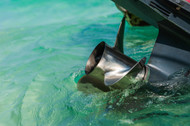How To Detect a Spun Outboard Propeller Hub
It’s time to head back to the dock. You drop the throttle, and your engine revs up like crazy, but your boat doesn’t move. Or maybe it moves very little, almost like there’s no propeller on the engine. You shut down the engine and tilt the drive up to check, and, yes, the prop is still there. So what’s going on? You could have a “spun” propeller hub. In other words, the propeller is no longer being turned by the engine because the hub has failed.
To understand the problem, let’s first define some terms. The hub of a propeller is within the barrel, which is the cylinder that supports the prop blades. The hub is the interface between the propeller and the propeller shaft of either an outboard or a sterndrive engine. A splined metal insert at the center of the hub mates to the splines on the propeller shaft. Between this insert and the inside of the barrel is a cushioning device. On older propellers, and on current Mercury propellers for motors 30hp and less, this cushion is a rubber-like sleeve that is pressed into the prop barrel and held in place by its own tension.
![]()
What Causes a Spun Prop?
The rubber inner bushing inside an outboard propeller hub is designed to absorb the shock created by shifting. The rubber hub bushing also serves as a “breakaway” should you strike something, allowing the prop to spin, and so protecting drive train components like gears. Once a hub is spun, generally there remains enough friction to operate at low RPM – sort of a “get home” mode. But, when RPM is increased, the engine revs with little or no boat acceleration because the prop begins to spin. A spun hub feels like a loss of power with excessive RPM. You will likely feel the prop slipping at high RPM. Sometimes, the hub only spins when the engine revs above a certain RPM, causing many boaters to wonder if they have spun a hub, are experiencing ventilation or cavitation, or have some kind of gear or power issue with their outboard.
How to Check for a Spun Prop Hub
To tell if your hub has spun, mark a line on the back of the prop hub with lipstick. You can also score your mark using a file. With the mark in place over the inner and outer hub, it’s a simple matter to pull the prop and see if the mark has broken in two. If it has, you have spun a hub.
How to Fix a Spun Prop Hub
You’ll likely want to take it to a marine mechanic or prop shop if you’re not handy. Prop hub replacement cost is often anywhere from $50 to $100, depending on your engine and where you take it. Fixing the prop requires pressing out the old hub and replacing it with a new hub. If you have the proper tools, you can do this process yourself.
To find out more about what we currently have in stock, contact us today!

Posted by Igor Stravinsky


